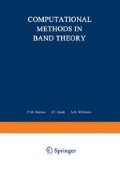Abstract
Solution of electronic problems involving plane surfaces on crystals requires solution of the band problem for real energy E in complex k space, and superposition of the generalized Bloch functions at the surface. A compact and general formulation of the problem of finding these Bloch functions and matching them across a plane makes use of a numerical matrix, the propagation matrix P, obtained from the Schrodinger equation. The eigenvectors of P are just the desired Bloch functions, and the eigenvalues give all k⊥ values at given E, k// (component parallel to the surface). Thus once P is found, the band problem is reduced to an ordinary eigenvalue problem; the bands can be followed along any line in k space parallel to k⊥ by varying k//; the potential may be complex (to describe inelastic scattering). A procedure for generating P by integration of a matrix equation has the advantage that a general anistropic potential can be used, but the disadvantage of a Fourier expansion parallel to the surface plane which does not hold well near the nucleus; hence it applies best for potentials that are weak or have a small number of Fourier coefficients. By generating P for a single layer by a two-dimensional version of KKR, this limitation is avoided for muffin-tin potentials.
Access this chapter
Tax calculation will be finalised at checkout
Purchases are for personal use only
Preview
Unable to display preview. Download preview PDF.
References
Beeby, J. L., 1968, “The Diffraction of Low Energy Electrons by Crystals,” J. Phys. C., Proc. Phys. Soc. 1, 82–87.
Ham, F. S., and Segall, B., 1961, “Energy Bands in Periodic Lattices — Green’s Function Method,” Phys. Rev. 124, 1786–96.
Heine, V., 1963, “On the General Theory of Surface States and Scattering of Electrons in Solids,” Proc. Phys. Soc. 81, 300–10.
Heine, V., 1964, “Some Theory About Surface States,” Surf. Sci. 29 1–7.
James, R. W., 1950, The Optical Principles of the Diffraction of X-Rays (G. Bell and Sons, Ltd., London ), Chap. II.
Kambe, K., 1967a, “Theory of Low-Energy Electron Diffraction I. Application of the Cellular Method to Monatomic Layers,” Z. Naturforsch. 22a, 322–30.
Kambe, K., 1967b, “Theory of Electron Diffraction by Crystals I. Green’s Function and Integral Equation,” ibid., 22a 422–31.
Kambe, K., 1968, “Theory of Low-Energy Electron Diffraction II. Cellular Method for Complex Monolayers and Multilayers,” ibid., 23a, 1280–94.
Kambe, K., This Proceedings, previous paper.
Kestner, N. R., Jortner, J., Cohen, M. H., and Rice, S. A., 1965, “Low-Energy Elastic Scattering of Electrons and Positrons from Helium Atoms,” Phys. Rev. 140, A56–66.
Korringa, J., 1947, “On the Calculation of the Energy of a Bloch Wave in a Metal,” Physica 134, 392–400.
McRae, E. G., 1968, “Electron Diffraction at Crystal Surfaces I. Generalization of Darwin’s Dynamical Theory,” Surf. Sci. 11, 479–91.
McRae, E. G., and Jennings, P. J., 1969, “Surface-State Resonances in Low-Energy Diffraction,” ibid., 345–48.
McRae, E. G., and Jennings, P. J., 1970, “Electron Diffraction at Crystal Surfaces IV. Computation of LEED Intensities for Muffin-Tin Models with Application to Tungsten (001),” to be published in Surf. Sci.
Morse, P. M., and Feshbach, H., 1953, Methods of Theoretical Physics (McGraw-Hill Book Company, Inc., New York).
Pendry, J. B., and Forstmann, F., 1970, “Complex Band Structure in the Presence of Bound States and Resonances,” J. Phys., Proc. Phys. Soc. 34, 59–69.
Slater, J. C., 1937, “Damped Electron Waves in Crystals,” Phys. Rev. 51, 840–846.
Williams, A. R., 1970, “Non-Muffin-Tin Energy Bands for Silicon by the Korringa-Kohn-Rostoker Method,” ibid, B1, 3417–26.
Ziman, J. M., 1965, “The T Matrix, The K Matrix, d Bands, and ℓ-Dependent Pseudo-Potentials in the Theory of Metals,” Proc. Phys. Soc. 86, 337–53.
Author information
Authors and Affiliations
Editor information
Editors and Affiliations
Rights and permissions
Copyright information
© 1971 Plenum Press, New York
About this chapter
Cite this chapter
Jepsen, D.W., Marcus, P.M. (1971). The Propagation Matrix Method for the Band Problem with a Plane Boundary. In: Marcus, P.M., Janak, J.F., Williams, A.R. (eds) Computational Methods in Band Theory. The IBM Research Symposia Series. Springer, Boston, MA. https://doi.org/10.1007/978-1-4684-1890-3_34
Download citation
DOI: https://doi.org/10.1007/978-1-4684-1890-3_34
Publisher Name: Springer, Boston, MA
Print ISBN: 978-1-4684-1892-7
Online ISBN: 978-1-4684-1890-3
eBook Packages: Springer Book Archive

